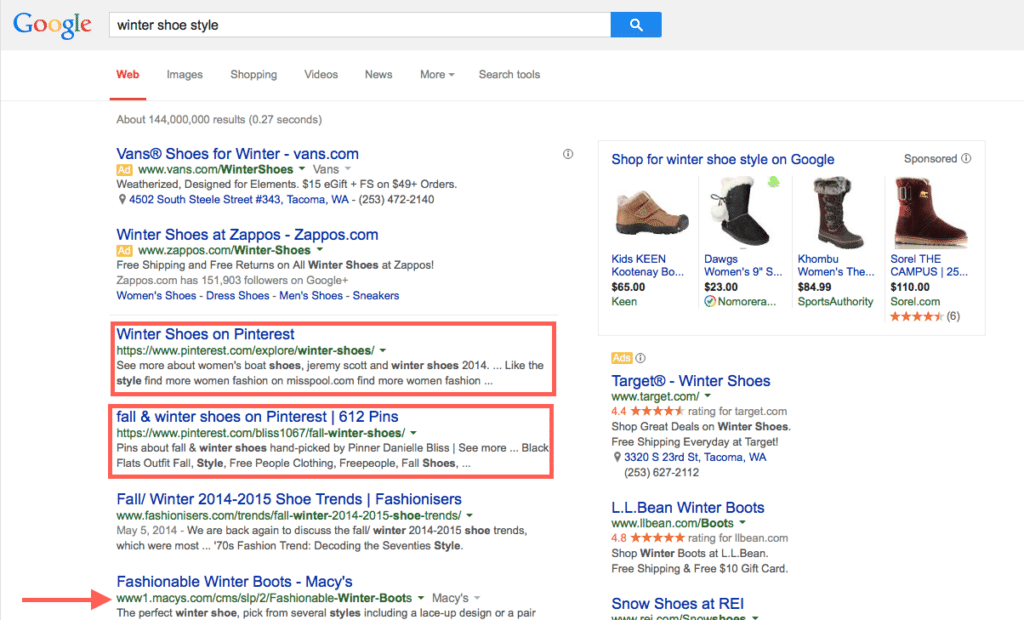Pinterest is now second to Tumblr on the list of fastest growing social media platforms – it’s also turning out to be highly effective at getting placement in search engine rankings and thus creating referral traffic to your site. If your brand is already finding success on Pinterest, you should consider making sure your Pinterest board is doing double duty – helping you get discovered in search engines.
So how exactly does it work? Let’s get some shoes.
So if Pinterest is helpful for SEO, you’re probably wondering exactly how. Well, it doesn’t change overall rank improvement for your site if that’s what you’re wondering (that is, social signals still aren’t a thing yet).
Lets look at an example. If you sell winter shoes and you want to rank highly for consumers searching for winter shoes and style ideas (early stages of the shopping process), good luck showing up in the top 5 search results. But look at the actual results for a potential search term, “winter shoe style.”
The top two ‘organic’ results returned are Pinterest pages:

This search was performed through the anonymity of a safe mode browser, to remove as much cookie bias as possible.
The key here is to be above the fold. The only retailer showing up in organic search is your big-name competitor, Macy’s. What are the chances your niche shoe business will show up ahead of such a big retailer? Pretty slim. But what if your brand had a presence on those Pinterest boards? All of a sudden, you’re getting organic traffic from your Pinterest presence, indirectly from Google. Investing time and resources in Pinterest will not only pay off by building a social presence, it can boost organic traffic to your site as well.
So, why not build your page around getting discovered and getting found in those top Google/Pinterest searches? Here’s a little checklist to help you get started.
The top 7 things you can do right now to improve your Pinterest game*:
1. Make your boards visible to search engines
Getting indexed by search engines is the first step, you’re either there or you’re not. This is a simple set up in your settings, so go do it.
2. Verify your website with your Pinterest account
Like many other social sites, Pinterest allows you to verify your business along with your website, adding a level of security and confidence with your audience.
3. Optimize, optimize, optimize: Implement keywords used by your target audience
That means optimizing the company name, the ‘about’ description, pin boards, pin descriptions, pin photo alt. text, categories, pin links, rich pins and hashtags. Select useful keywords so when your target audience goes searching, your pins are awaiting their clicks, favorites and repins.
4. Keep popular pins and boards above the fold
Your popular boards are popular for a reason. Help them continue to grow by making sure they’re above the fold on your Pinterest page. Your popularity on Pinterest will directly influence whether or not Google will choose your board or pin to show up for a specific keyword.
5. Don’t forget about the analytics dashboard
About a year ago, Pinterest joined the ranks of Twitter, LinkedIn, Facebook and Google+ by allowing companies to view their pins and page’s performance. Make sure you take a look, see what’s working and what’s not.
6. Create an engagement strategy to grow board and page popularity
The set-it and forget-it model does not actually apply here (although Pinterest content is known for being especially evergreen). Create a strategy centered around developing relationships with pinners and getting your pins seen.
7. Make your website pinnable
Optimizing your Pinterest board and pins is one thing. You should also make sure there’s a fluid exchange between the two; as easy as it should be for a user to get to your website from Pinterest, it should be just as easy for him or her to distribute your website’s content on Pinterest. There are plenty of plugins and apps you can use to accomplish this.
Start with these 7 tools and you should be on the right track to success! As you can tell by the example, this type of strategy works well for niche audiences and specific, targeted keyword searches. Before you get started on Pinterest you should already know if this might work for your audience and complete your due diligence to define your audience and keywords.
*Note, as with any social media site, you should only use Pinterest if it’s something that makes sense within your broader social media and marketing plan. Many B2B companies and services firms have trouble finding a place on the platform, but there are many businesses finding a place.

